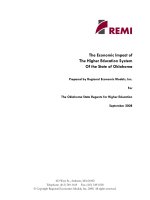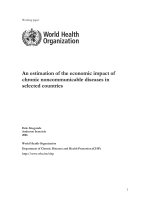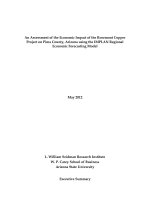Honey Bees: Estimating the Environmental Impact of Chemicals - Chapter 6 pps
Bạn đang xem bản rút gọn của tài liệu. Xem và tải ngay bản đầy đủ của tài liệu tại đây (1.02 MB, 16 trang )
6 Effects of imidacloprid on the
neural processes of memory
in honey bees
C. Armengaud, M. Lambin, and
M. Gauthier
Summary
The cholinergic system in insects is the main target of insecticides. One
class of molecules, the neonicotinoids, induces direct activation of the neu-
ronal nicotinic acetylcholine receptors (nAChRs). In the honey bee these
receptors are mainly distributed in the olfactory pathways that link
sensory neurons to antennal lobes and mushroom bodies. These structures
seem to play an important role in olfactory conditioning. We have previ-
ously shown that cholinergic antagonists injected in different parts of the
brain impaired the formation and retrieval of olfactory memory. We then
advanced the hypothesis that, through the activation of the nAChR, the
neonicotinoid imidacloprid (IMI) would lead to facilitation of the memory
trace.
To test this hypothesis, IMI was applied topically upon the thorax and
the effects were tested on the habituation of the proboscis extension reflex
induced by repeated sugar stimulation of the antennae. Animals treated
with IMI to a dose that did not affect sensory or motor functions needed
fewer trials than nontreated animals to show a reflex inhibition. This effect
can be interpreted as a learning facilitation.
We developed a functional histochemistry of cytochrome oxidase (CO)
to reveal the brain targets of the drug in the honey bee brain. Following
IMI injection, a CO staining increase, probably linked to an increase in
metabolism, was observed in the antennal lobes. In integrative structures,
in particular the calyces of mushroom bodies, IMI exerted a facilitatory or
inhibitory effect on neuronal metabolism depending on the dose. The
brain targets of nicotinic ligands, including pesticides, can be compared by
using this technique.
Introduction
Two of the three main classes of insecticides exert their neurotoxic effects
through action on the cholinergic system. This is the case for the new class
of neonicotinoids, which are known to act on the nicotinic acetylcholine
© 2002 Taylor & Francis
receptor (nAChR) channel. Imidacloprid (IMI) {1–[(6-chloro-3-
pyridinyl)methyl]-4,5-dihydro-N-nitro-1H-imidazol-2-amine} is one of
these new molecules (Figure 6.1). According to the literature, IMI in
insects acts at three pharmacologically distinct acetylcholine receptor sub-
types inducing a dose-dependent depolarization [1]. Other electrophysio-
logical effects of IMI have been described in different models. The single
patch-clamp technique applied to the rat pheochromocytoma (PC 12) cells
showed that the molecule may have both agonist and antagonist effects on
the nAChR [2–4]. Binding experiments of [
3
H]IMI to membranes from
different species showed high-affinity binding sites in house fly head [5],
and high- and low-affinity binding sites in the aphid Myzus persicae [6].
The nicotinic receptor subunit composition seems to exert a profound
influence upon IMI binding affinity [7]. This brief review of the literature
underlines the complex action of IMI on the nAChR.
The neurotransmitter acetylcholine (ACh) is distributed largely in the
honey bee brain [8]. Acetylcholinesterase and ACh receptors have been
identified in the antennal lobes and in the mushroom bodies (MBs),
particularly in the calycal part [9, 10]. In addition, Kenyon cells, which fill
the calyces, express functional nAChRs in vitro [11]. The involvement of
the cholinergic system in memory processes in the honey bee has been
demonstrated by intracranial injections of cholinergic antagonists using a
classical conditioning procedure [12–14]. Local brain injections have shown
that the nAChR antagonist mecamylamine impaired the recall or the
formation of the memory trace depending on the brain site injection and
86 C. Armengaud et al.
Figure 6.1 Chemical structures of acetylcholine and nicotinic cholinoceptor ligands
used in this study.
© 2002 Taylor & Francis
the moment of the injection relative to the conditioning trial. From these
experiments, we postulated that ACh, as in vertebrates, exerts a facilitatory
effect on memory processes. We made the hypothesis that activation of the
cholinergic pathways with agonists like those molecules belonging to the
neonicotinoids would facilitate the formation and/or the recall of memory.
To test this hypothesis, we submitted honey bees to the habituation of
the proboscis extension reflex (PER). This nonassociative learning para-
digm can be easily used to detect the behavioral effect of different kinds of
molecules. The PER is induced by antennal sucrose stimulation and
involves activation of motor neurons situated in the subesophageal gan-
glion and driving the mouthpart muscles. The repetition of this non-
noxious stimulation leads to a decrease in the response occurrence. We
postulated that IMI could reduce the number of stimulations needed to
observe the response decrease. However, given the neurotoxic action of
IMI, the absence of the PER could indicate a problem of gustatory per-
ception or a central motor disruption. In preliminary experiments, we
defined the IMI dose that did not induce modifications of the gustatory
threshold or a perturbation of motor activity.
The involvement of mushroom bodies in memory processes is well
established in insects. Consequently imidacloprid brain targets were inves-
tigated using cytochrome oxidase (CO) histochemistry. CO activity is com-
monly used in vertebrates as an endogenous metabolic marker of neuronal
activity. Energy demand due to neuronal activity increases the production
of oxidative energy [15]. Classically, CO histochemistry is used in verte-
brates to identify a pathological modification [16, 17] or the effect of
chronic surgical and pharmacological treatments [18–20]. We attempted to
develop a functional histochemistry of CO in honey bee brain that allowed
the analysis of the short-term effect of cholinergic ligands including IMI
on the metabolism of the different brain structures [21].
Materials and methods
Worker honey bees (Apis mellifera) were caught at the hive entrance and
maintained with food and water ad libitum in small Plexiglas boxes until
the beginning of the experiments. To evaluate the gustatory threshold and
for learning and metabolism experiments, honey bees were immobilized
individually in small plastic tubes with a drop of wax–collophane mixture
laid between the dorsal part of the thorax and the tube. The head and the
prothoracic legs were free to move, allowing the honey bee to clean its
antennae from the repeated sucrose stimulations. Honey bees underwent a
2-hour starvation period before the beginning of the experiments.
Imidacloprid (Cluzeaux, France; molecular weight: 255.7; degree of
purity 98 percent) was dissolved in dimethyl sulfoxide (DMSO; Sigma)
to obtain a 10
Ϫ1
M solution. Lower concentrations were obtained with
successive dilutions in saline. Control groups were treated with DMSO
Neuronal effect of imidacloprid in the honey bee 87
© 2002 Taylor & Francis
dissolved in saline (vehicle) in the same proportions. For behavioral
experiments, the drug or vehicle was used in topical applications (1l) to
the thorax. Doses ranging from 1.25 to 5ng/bee were used which were
below the DL50 value (10 to 20ng/bee, defined for thoracic application to
Apis mellifera at 24h; unpublished observations from L.P. Belzunces). For
CO experiments, we tested the effect of intracranial injection of saline or
IMI on worker honey bees receiving an injection of 0.5l saline or IMI
(10
Ϫ4
, 10
Ϫ6
, or 10
Ϫ8
M) at the brain surface. Nicotine (10
Ϫ8
, 10
Ϫ6
, and
10
Ϫ4
M) and mecamylamine (10
Ϫ2
M) were also tested as nAChR agonist
and antagonist, respectively.
Behavioral tests
Gustatory threshold
The aim of this experiment was to study the effect of IMI on the gustatory
perception. The gustatory threshold was defined as the lowest concentra-
tion of a sucrose solution applied to the antennae able to elicit a proboscis
extension. The threshold was defined twice for each honey bee: first before
any treatment and then after IMI or vehicle application. Several doses of
IMI were used with several time-intervals between the application of the
drug and the test.
The gustatory threshold was determined as follows. Fasted honey bees
were submitted to antennal stimulations (1-minute intertrial interval) with
increasing concentrations of sucrose solutions ranging from M/1024 to 4M
and following a geometric progression (M/1024, M/512, M/256, etc.). The
range of increasing sucrose concentrations was applied twice separated by
a 5-minute interval. The lowest concentration of sucrose that elicits the
PER was defined as the gustatory threshold. Honey bees that failed to
respond to one of the sucrose solutions were discarded. The remaining
honey bees were fed with two drops of 50 percent (w/v) sucrose solution
and fasted for 2 hours. This was done to ensure that the gustatory thresh-
old determination under IMI application was made under the same moti-
vational state. The thoracic application of vehicle or IMI at a dose of 1.25,
2.50, or 5ng/bee was performed during the starvation period, 15 min, 30
min or 60 min before the second gustatory threshold determination. This
second determination was done like the first one. For data quantification,
any modification of the gustatory threshold between the two determina-
tions from one sucrose concentration to the one immediately lower or
higher was respectively quantified as Ϫ1 or ϩ1 arbitrary unit.
Locomotion
Locomotion of honey bees was tested in an open-field-like apparatus con-
sisting of a white Plexiglas box (30ϫ 30ϫ4cm) with a glass front for obser-
88 C. Armengaud et al.
© 2002 Taylor & Francis
vation. The back surface was divided into 5-cm
2
squares and the box was
illuminated from above. The box did not allow the honey bees to fly. A
hole made in the bottom right-hand side of the box allowed the introduc-
tion of a single honey bee for a 5-min observation period. The position of
the honey bee was recorded every 5s. The duration of successive 5-s
periods in the same square was reported as immobility as the locomotor
activity of the honey bee in the same square was very low, if nonexistent.
Otherwise, the honey bee was moving around. The effect of the drug on
locomotor activity was studied 15, 30, and 60 min after application of a
dose of 1.25, 2.50, and 5ng/bee and was compared to the effect of vehicle.
Habituation
Fasted honey bees were stimulated repeatedly with a 50 percent (w/v)
sucrose solution applied to one antenna at 1-min intervals. The habitua-
tion criterion was defined as three consecutive sucrose stimulations
without proboscis extension. When this criterion was reached, the sucrose
solution was applied to the controlateral antenna to rule out the eventual-
ity of motor tiredness. Honey bees that did not respond to the 50 percent
sucrose solution and to the restoration test of the reflex were discarded.
IMI was applied at 1.25ng/bee and the drug effect was tested after 15 min,
30 min or 1 hour in three independent groups. A group receiving no treat-
ment and a solvent-treated group were also added.
CO histochemistry
Thirty minutes after injection of the drug, the animals were killed by rapid
decapitation. Frontal sections (16m) from the whole brain were pre-
pared for CO histochemistry, according to Wong-Riley [20]. Quantifica-
tion of staining was performed by computer-aided densitometry of CO
histochemistry intensity. We focused our investigations on antennal lobes,
calyces, and ␣-lobes of MBs because it was previously shown that 30 min
after an injection of AChR antagonists in these structures, memory
processes were impaired [12, 13]. IMI was tested at concentrations of 10
Ϫ8
,
10
Ϫ6
, and 10
Ϫ4
M, corresponding to doses ranging from 1.28pg to 12.8ng
per honey bee. At higher doses IMI induced toxic and lethal effects.
Data analysis
Data sets were analyzed using a two-population independent two-tailed
t-test or an analysis of variance (
ANOVA). Figures show meansϮ s.e.m. In
all cases, P-values less than 0.05 were considered as significant.
Neuronal effect of imidacloprid in the honey bee 89
© 2002 Taylor & Francis
Results
Behavioral tests
Gustatory threshold
An increase in the gustatory threshold was observed between the first and
the second determinations whatever the treatment (Figure 6.2). A very
slight increase of less than one-half unit was found for the vehicle and for
the lowest doses of IMI (1.25 and 2.50ng/bee). Animals treated with the
vehicle (controls) were not different from those receiving no treatment
(data not shown). Groups that received 1.25 and 2.50ng IMI were not dif-
ferent from controls, so in subsequent habituation experiments, both doses
could have been used. A loss of sensitivity was noticed for the dose of 5ng
after 1 hour. This delayed effect seems not to be related to the time
needed by imidacloprid to reach the brain from the thoracic application
90 C. Armengaud et al.
15 min (n ϭ 20)
3
2
1
0
30 min (n ϭ 10)
60 min (n ϭ 10)
DMSO 1.25 ng 2.50 ng 5 ng
Treatment
Gustatory threshold
(mean arbitrary units Ϯ s.e.m.)
*
Figure 6.2 Variations of the gustatory threshold (arbitrary units) 15 min, 30
min, or 1h after thoracic application of DMSO (nϭ20 for each
time) or imidacloprid at different doses (1.25, 2.5, 5ng/bee). The
number of imidacloprid-treated animals is indicated on the graph.
*PϽ0.05.
© 2002 Taylor & Francis
site since the high dose of 20ng induces the same sensitivity loss as soon as
15 min after application (data not shown).
Locomotion
Opposite effects of IMI on motor displacements were observed depending
on the dose (Figure 6.3). Compared to the vehicle, the lowest dose of IMI
(1.25ng/bee) induced an increase in displacements independently of time
(shown as a decrease in immobility in Figure 6.3). A significant increase in
locomotion was also observed for 2.5ng/bee at 15 min. With 5ng, IMI
induced a decrease in the honey bee displacements in the box as soon as
30 min after application. The decrease in displacements was explained by a
loss of motor coordination. The honey bees fell down on their backs,
showing leg movements and body and wing shaking. Additional observa-
tions up to 2 hours after drug application showed that there was no behav-
ioral recovery.
Unlike the previous experiment on gustatory perception, we did not
observe a dose–effect relationship in this experiment, as there were more
Neuronal effect of imidacloprid in the honey bee 91
0
*
*
*
*
*
15 min
30 min
60 min
100
200
300
*
*
*
*
*
*
*
*
*
*
*
DMSO 1.25 ng 2.50 ng 5 ng
Treatment
Mean duration of immobility Ϯ s.e.m. (sec)
Figure 6.3 Time spent in immobility (seconds) in honeybees treated with
DMSO or imidacloprid at different doses (1.25, 2.5, 5ng/bee), 15
min, 30 min, or 1h before the test. nϭ 10 in each group. *PϽ0.05;
**PϽ0.01; ***PϽ 0.001.
© 2002 Taylor & Francis
numerous displacements at the lowest dose (1.25ng/bee). This dose was
retained to test the effect of IMI on habituation.
Habituation
Under IMI treatment (1.25ng/bee), honey bees needed fewer trials to
display PER habituation than honey bees receiving the vehicle or receiv-
ing no treatment (statistics highly significant in both cases, see Figure 6.4).
There was no effect of time on the facilitating effect. This observation is
closer to the enhancing effect of 1.25ng of IMI on displacements, which is
also independent of time. Dilute DMSO induced a slight but significant
reduction in the number of trials compared to the groups receiving no
treatment (statistics shown in Figure 6.4).
CO histochemistry
Histological modifications induced by IMI were of weak amplitude but
very reproducible: for example in the antennal lobe, IMI 10
Ϫ4
M induced a
92 C. Armengaud et al.
15 min
0
10
20
30
40
50
60
Number of trials to reach habituation
(mean Ϯ s.e.m)
30 min
60 min
Time interval between treatment and test
ϩ
ϩ
ϩ
ϩ
ϩ
ϩ
ϩ
ϩ
ϩ
*
*
*
ϩ
ϩ
ϩ
*
*
*
ϩ
ϩ
ϩ
ϩ
ϩ
ϩ
*
*
*
No treatment
DMSO
Imidacloprid
Figure 6.4 Number of trials required to reach habituation in animals receiving no
treatment or animals treated topically with DMSO or imidacloprid
(1.25ng/bee) 15 min, 30 min, or 1h before learning. n ϭ 20 in each
group. ϩϩϩcomparison to ‘No treatment’, P Ͻ 0.001. ***comparison to
DMSO, PϽ0.001.
© 2002 Taylor & Francis
staining increase in all the experiments performed. The intensity of stain-
ing was analyzed in the cortical layer and in the internal area of the
glomeruli. At the concentrations of 10
Ϫ4
, 10
Ϫ6
, and 10
Ϫ8
M, a significant
increase in staining was obtained for the two regions of the glomeruli. The
increment ranged from ϩ8 percent to ϩ17 percent. A dose–response
effect was observed for this structure (Figure 6.5A).
The greatest modifications of CO labeling induced by IMI were
observed in the ␣-lobe stratification, corresponding for the dorsal layer B1,
to ϩ23 percent of the saline group labeling (Figure 6.5B). For 10
Ϫ4
M the
increment was significant in the dorsal, intermediate and ventral layers
(B1, B2, and B3).
In the calyces the 10
Ϫ8
M IMI injection induced a significant reduction
in the labeling (Figure 6.5C). In the basal ring the mean gray level of the
10
Ϫ6
M group was significantly lower compared to the saline group.
In the 10
Ϫ4
M IMI-treated group, the CO staining in the upper (UD)
and lower (LD) divisions of the central body was significantly greater than
that of the saline group; the opposite effect was observed for 10
Ϫ8
M
(Figure 6.5D).
In subsequent experiments other nAChR ligands were tested. CO was
stimulated by nicotine in a dose-dependent manner in many brain
regions (data not shown). In particular, the internal part of the glomeruli
exhibited significant increases of 19 percent at 10
Ϫ4
M nicotine (Figure
6.6A).
The effects of nicotine were statistically significant in the B1, B2, and
B3 layers of the ␣-lobe (Figure 6.6B). The greatest stimulation by 10
Ϫ4
M
nicotine administration was obtained for the B3 layer (ϩ23 percent).
Moreover, for the ventral layer a significant increase was still present after
10
Ϫ8
M (data not shown).
In calyces, whatever the concentration of nicotine tested, no significant
differences were found between the saline and nicotine groups whereas
10
Ϫ4
M IMI induced an increase in labeling. Moreover, 30 min after 10
Ϫ8
M
IMI injection, a decrease in brain metabolism was observed in the central
body, calyces, and ␣-lobe which was not observed with nicotine injection
to the same concentration and at the same interval.
Changes in the metabolic activity of the honey bee brain were exam-
ined following nAChR antagonist (mecamylamine) administration to high
concentration (10
Ϫ2
M) inducing an impairment of retrieval processes [13].
Comparison between saline- and antagonist-treated brains indicates that
mecamylamine induced a significant decrease in neural metabolism in the
␣-lobe (Figure 6.6B) and no effect in the other structures (Figure 6.6A, C,
D). Like IMI and nicotine, mecamylamine has a significant effect on the
␣-lobe.
Neuronal effect of imidacloprid in the honey bee 93
© 2002 Taylor & Francis
Figure 6.5 Relative variation of CO histochemistry induced by imidacloprid.
(A) Antennal lobe: glomeruli cortical area, glomeruli internal
area. (B) ␣-Lobe: B1, dorsal layer; B2, intermediate layer;
B3, ventral layer. (C) Calyces: lip area, basal ring area. (D) Central
body: UD, upper division of central body; LD, lower division
© 2002 Taylor & Francis
of central body. Each imidacloprid-treated brain value was expressed
as (treatedϫ100/saline)Ϫ 100. 0% represents optical density of
saline group. MeanϮs.e.m was obtained by averaging the brain per-
centage variation of nϭ21 (10
Ϫ4
M), nϭ8 (10
Ϫ6
M), nϭ8 (10
Ϫ8
M)
honey bees.
© 2002 Taylor & Francis
Figure 6.6 Effect of nicotine (10
Ϫ4
M) and the nicotinic AChR antagonist mecamy-
lamine (10
Ϫ2
M) on cytochrome oxidase histochemistry in antennal lobe
(A), ␣-lobe (B), calyce (C), and central complex (D). Abbreviations
and result expression as in Figure 6.5.
© 2002 Taylor & Francis
© 2002 Taylor & Francis
Discussion
Our hypothesis that IMI at a low dose (1.25ng/bee corresponding to a
micromolar concentration) could facilitate a simple form of learning is
verified.
The experiments show a hierarchical effect of IMI applied topically.
This effect depends on the physiological function tested. It seems that gus-
tatory perception is less sensitive to the insecticide than motor function or
learning processes. The first manifestation of the drug on the gustatory
threshold appeared at 5ng/bee after 1 hour whereas a strong effect of the
drug at the dose of 1.25ng/bee was observed on the other functions after
the shortest interval. We do not retain the possibility that the drug needs
more time to diffuse from the thorax to the brain than to the ventral nerve
cord. The high doses of 10 and 20ng induced a large increase in the gusta-
tory threshold as soon as 30 min after application (results not shown).
An interesting finding in this work is the dual effects of IMI on motor
displacements and brain metabolism depending on the dose. The locomo-
tor activation observed at the lowest dose could indicate the specific effect
of the drug linked to nicotinic activation whereas the higher doses would
induce a nonspecific toxic effect. The complex effect of IMI on neuronal
metabolism has also been observed after intracranial injection of the insec-
ticide in the honey bee. All of the 10 regions analyzed showed a significant
staining increase for the highest concentration (10
Ϫ4
M). For the lower con-
centrations (10
Ϫ6
and 10
Ϫ8
M) a regional sensitivity and specificity were
observed. The effect of IMI in the antennal lobes, the first relay of the
olfactory information, was always an increase in metabolism. In integrative
structures, in particular the calyces, the action of IMI is more complex. Low
concentrations induced inhibition of CO histochemistry whereas high con-
centrations resulted in activation of CO. In a preliminary experiment brain
injections of the nAChR antagonists mecamylamine and hexametonium
only induced a decrease in the labeling. Hence, we were waiting for the
agonist stimulating action of IMI. The electrophysiological effects of IMI
are also complex. Modulation of the nAChR channel by IMI has been
demonstrated in pheochromocytoma cells, corresponding to both multiple
agonist and antagonist effects on acetylcholine-induced currents [2, 4].
Finally, the dual effect of IMI can be explained by the presence in the
central nervous system of the honey bee of two types of nicotinic receptors
as shown in the cockroach nervous system [1]. Stimulating effects, such as
depolarization of the cockroach cercal afferent giant interneuron and
inward currents with activation of the hybrid nAChR, were obtained with
concentration up to 10
Ϫ6
M [1, 22]. At 100nM, IMI reversibly reduced the
amplitude of the ACh responses recorded on SAD2 hybrid receptors
expressed in Xenopus oocytes [22]. Using [
3
H]IMI, high- and low-affinity
nAChR-like binding sites have been characterized in the aphid Myzus
periscae [6]. The dual agonist/antagonist effects of IMI on CO histochem-
98 C. Armengaud et al.
© 2002 Taylor & Francis
istry could be linked to the presence of different subtypes of receptors in
the different neuropiles. It is not out of the question that a desensitization
of nAChRs would be induced with the concentration of 10
Ϫ4
M IMI; desen-
sitization was described in the cockroach in response to 10
Ϫ5
M IMI [1]. In
our experiment the specific effect of IMI would be observed with 10
Ϫ8
M
and corresponds to an increase in metabolism in the antennal lobes and a
decrease in metabolism in integrative structures. However, agonist action
(nicotine-like) of IMI, observed with the highest concentration (10
Ϫ4
M),
may contribute to the toxicity of this insecticide.
In conclusion, these results support our hypothesis that the cholinergic
system is involved in learning processes in insects. We have previously
shown that cholinergic antagonists impair the formation and recall of olfac-
tory memory [12–14]. We show now that activation of the cholinergic
system with IMI facilitates a reflex habituation. However, to demonstrate
that the facilitatory effect is general and not limited to nonassociative
learning, we have to submit IMI-treated honey bees to different tasks such
as, for example, discriminative olfactory conditioning between reinforced
and nonreinforced odors. However, this facilitatory effect is not so easy to
understand at the cellular level. A simple hypothesis to advance is that the
dose used in behavioral experiments (corresponding to a micromolar con-
centration) induces neuronal activation. This is not what is observed with
CO experiments. At the concentration of 10
Ϫ6
M, IMI induces a slight or no
effect on brain metabolism. Our findings suggest that IMI exerts multiple
actions at nAChRs. A new approach is currently being developed. Using
the patch-clamp technique, ACh-ionic currents and their IMI-induced
modifications are recorded in cultured Kenyon cells to see whether IMI
behaves as an agonist or an antagonist on the honey bee nAChR.
References
1 Buckingham, S.D., Lapied, B., Le Corronc, H., Grolleau, F. and Satelle, B.
(1997). Imidacloprid actions on insect neuronal acetylcholine receptors. J. Exp.
Biol. 200, 2685–2692.
2 Nagata, K., Aistrup, G.L., Song, J.H. and Narahashi, T. (1996). Subconduc-
tance-state currents generated by imidacloprid at the nicotinic acetylcholine
receptor in PC 12 cells. NeuroReport 7, 1025–1028.
3 Nagata, K., Iwanaga, Y., Shono, T. and Narahashi, T. (1997). Modulation of the
neuronal nicotinic acetylcholine receptor channel by imidacloprid and cartap.
Pestic. Biochem. Physiol. 59, 119–128.
4 Nagata, K., Song, J.H. and Narahashi, T. (1998). Modulation of the neuronal
nicotinic acetylcholine receptor-channel by the nitromethylene heterocycle imi-
dacloprid. J. Pharmacol. Exp. Ther. 285, 731–738.
5 Liu, M Y. and Casida, J.E. (1993). High affinity binding of [
3
H]imidacloprid in
the insect acetylcholine receptor. Pestic. Biochem. Physiol. 46, 40–46.
6 Lind, R.J., Clough, M.S., Reynolds, S.E. and Early, F.G.P. (1998). [
3
H]Imida-
cloprid labels high- and low-affinity nicotinic acetylcholine receptor-like
Neuronal effect of imidacloprid in the honey bee 99
© 2002 Taylor & Francis
binding sites in the aphid Myzus periscae (Hemiptera: Aphididae). Pestic.
Biochem. Physiol. 62, 3–14.
7 Lansdell, S.J. and Millar, N.S. (2000). The influence of nicotinic receptor
subunit composition upon agonist, alpha-bungarotoxin and insecticide (imida-
cloprid) binding affinity. Neuropharmacology 39, 671–679.
8 Breer, H. (1987). Neurochemical aspects of cholinergic synapses in the insect
brain. In: Arthropod Brain. Its Evolution, Development, Structure and Func-
tions (Gupta, A.P., Ed.), Wiley, New York, pp. 415–437.
9 Kreissl, S. and Bicker, G. (1989). Histochemistry of acetylcholinesterase and
immunocytochemistry of an acetylcholine receptor-like antigen in the brain of
the honey bee. J. Comp. Neurol. 286, 71–84.
10 Scheidler, A., Kaulen, P., Brüning, G. and Erber, J. (1990). Quantitative
autoradiographic localization of
125
I ␣-bungarotoxin binding sites in the honey-
bee brain. Brain Res. 534, 332–335.
11 Goldberg, F., Grünewald, B., Rosenboom, H. and Menzel, R. (1999). Nicotinic
acetylcholine currents of cultured Kenyon cells from the mushroom bodies of
the honeybee Apis mellifera. J. Physiol. 514, 759–768.
12 Gauthier, M., Cano Lozano, V., Zajoual, A. and Richard, D. (1994). Effects of
intracranial injections of scopolamine on olfactory conditioning retrieval in the
honey bee. Behav. Brain Res. 63, 145–149.
13 Cano Lozano, V., Bonnard, E., Gauthier, M. and Richard, D. (1996). Mecamy-
lamine-induced impairment of acquisition and retrieval of olfactory condition-
ing in the honey bee. Behav. Brain Res. 81, 215–222.
14 Cano Lozano, V. and Gauthier, M. (1998). Effects of the muscarinic antago-
nists atropine and pirenzepine on olfactory conditioning in the honey bee.
Pharmacol. Biochem. Behav. 59, 903–907.
15 Wong-Riley, M.T.T. (1998). Cytochrome oxidase: An endogenous metabolic
marker of neuronal activity. Trends Neurosci. 12, 94–101.
16 Brines, L.M., Tabuteau, H., Sundaresan, S., Kim, J., Spencer, D.D. and de
Lanerolle, N. (1995). Regional distribution of hippocampal Na
ϩ
,K
ϩ
-ATPase,
cytochrome oxidase, and total protein in temporal lobe epilepsy. Epilepsia 36,
371–383.
17 Mutisya, E.M., Bowling, A.C. and Flint Beal, M. (1994). Cortical cytochrome
oxidase activity is reduced in Alzheimer’s disease. J. Neurochem. 63, 2179–2184.
18 Cada, A., Gonzalez-Lima, F., Rose, G.M. and Bennett, M.C. (1995). Regional
brain effects of sodium azide treatment on cytochrome oxidase activity: A
quantitative histochemical study. Metab. Brain Dis. 10, 303–320.
19 Rubio, S., Begega, A., Santin, L.J. and Arias, J.L. (1996). Ethanol- and
diazepam-induced cytochrome oxidase activity in mammillary bodies. Pharma-
col. Biochem. Behav. 55, 309–314.
20 Wong-Riley, M.T.T (1979). Changes in the visual system of monocular sutured
or enucleated cats demonstrable with cytochrome oxidase histochemistry.
Brain Res. 171, 11–28.
21 Armengaud, C., Aït-Oubah, J. and Gauthier, M. (1998). Functional staining of
cytochrome oxidase activity in the honey bee brain. J. Eur. Neurosci. 10 (Suppl.
10), 260.
22 Matsuda, K. Buckingham, S.D., Freeman, J.C., Squire, M.D., Bayliss, H.A. and
Sattelle, D.B. (1998). Effects of the ␣ subunit on imidacloprid sensitivity of
recombinant nicotinic acetylcholine receptors. Br. J. Pharmacol. 123, 518–524.
100 C. Armengaud et al.
© 2002 Taylor & Francis









